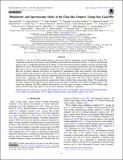Photometric and spectroscopic study of the EXor-like eruptive young star Gaia19fct
Abstract
Gaia19fct is one of the Gaia-alerted eruptive young stars that has undergone several brightening events. We conducted monitoring observations using multifilter optical and near-infrared photometry, as well as near-infrared spectroscopy, to understand the physical properties of Gaia19fct and investigate whether it fits into the historically defined two classes. We present the analyses of light curves, color variations, spectral lines, and CO modeling. The light curves show at least five brightening events since 2015, and the multifilter color evolutions are mostly gray. The gray evolution indicates that bursts are triggered by mechanisms other than extinction. Our near-infrared spectra exhibit both absorption and emission lines and show time variability throughout our observations. We found lower rotational velocity and lower temperature from the near-infrared atomic absorption lines than from the optical lines, suggesting that Gaia19fct has a Keplerian rotating disk. The CO overtone features show a superposition of absorption and emission components, which is unlike other young stellar objects. We modeled the CO lines, and the result suggests that the emission and absorption components are formed in different regions. We found that although Gaia19fct exhibits characteristics of both types of eruptive young stars, FU Orionis–type objects and EX Lupi–type objects, it shows more similarity with EXors in general.
Citation
Park , S , Kóspál , Á , Ábrahám , P , Cruz-Sáenz de Miera , F , Fiorellino , E , Siwak , M , Nagy , Z , Giannini , T , Carini , R , Szabó , Z M , Lee , J-E , Lee , J-J , Vitali , F , Kun , M , Cseh , B , Krezinger , M , Kriskovics , L , Ordasi , A , Pál , A , Szakáts , R , Vida , K & Vinkó , J 2022 , ' Photometric and spectroscopic study of the EXor-like eruptive young star Gaia19fct ' , Astrophysical Journal , vol. 941 , no. 2 , 165 . https://doi.org/10.3847/1538-4357/aca01e
Publication
Astrophysical Journal
Status
Peer reviewed
ISSN
0004-637XType
Journal article
Description
Funding: This project has received funding from the European Research Council (ERC) under the European Union's Horizon 2020 research and innovation program under grant agreement No. 716155 (SACCRED) and from the "Transient Astrophysical Objects" GINOP 2.3.2-15-2016-00033 project of the National Research, Development and Innovation Office (NKFIH), Hungary, funded by the European Union. We acknowledge support from ESA PRODEX contract No. 4000132054. Zs.N., L.K., and K.V. acknowledge the support by the János Bolyai Research Scholarship of the Hungarian Academy of Sciences. K.V. is supported by the Bolyai+ grant UNKP-22-5-ELTE-1093. This project has been supported by the K-131508 grant of the Hungarian National Research, Development and Innovation Office (NKFIH) and the Élvonal grant KKP-143986. Authors acknowledge the financial support of the Austrian-Hungarian Action Foundation (101.u13, 104.u2). L.K. acknowledges the financial support of the Hungarian National Research, Development and Innovation Office grant NKFIH PD-134784. This project has received funding from the European Union's Horizon 2020 research and innovation program under grant agreement No. 101004719 (OPTICON-RadioNet Pilot).Collections
Items in the St Andrews Research Repository are protected by copyright, with all rights reserved, unless otherwise indicated.

